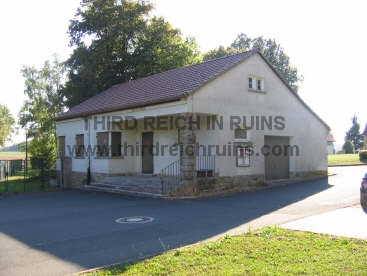|
Luftwaffe
Munitions Depot Rottershausen
A LuftMuna, or Luftmunitionsanstalt (ammunition storage
and assembly site
for the Luftwaffe) was built in the woods near the village of Rottershausen,
north of Schweinfurt, in 1943. This site contained several bunkers, some partly
underground, storing aircraft bombs and ammunition for the Schweinfurt flak batteries. All were camouflaged with earth and vegetation to guard against
aerial reconnaissance. A rail line was built for quick access into the area.
Many of the
bunkers were blown up by retreating German troops on the night of 4-5 April 1945.
American forces apparently destroyed others after the war. Others were removed
in 2004.
After the war this area was used as
an ammunition storage site by the U.S. Army, and part of it is still closed off
(most of the existing above-ground bunkers are still in use, mostly by the Bundes Grenzschutz (German Border Patrol troops).
(Check the Contents
Page for links to other Munas found on the "Third Reich in Ruins"
page.)
|

|

|
|
The main entrance road to the
site was flanked by well-constructed rock walls. |
|

|

|
|
Above-ground ammo bunkers at the
Rottershausen site. The one on the left is intact and still in use. The
photo on the right shows the entrance to one of the many destroyed
bunkers. Only the
rectangular shells remain, along with the concrete entryways. |
|

|

|
|
Entrances to below-ground Luftschutz
(air raid) bunkers for the Muna personnel. (Actually, these bunkers were probably built in shallow
depressions, then covered with earth - not actually dug into the ground
like a tunnel.) Note - the
bunkers shown here were removed in 2004. |
|

|

|
|
Below-ground Luftschutz bunker located
beside the rail line into the storage area. On the left is one of the
entrances (partially filled in); on the right is the interior of the
main room. Each Luftschutz bunker consisted of a right-angle entryway, a small
passage, then the main room, which configuration was repeated on the
other side for the back exit. |
|

|

|
| A
blown up bunker for storage of fuzes. These Zünderbunker, all
located near the rail line, had concrete steps
leading to their elevated entrances. |
|

|

|
|
The rail station at the
Rottershausen Munitions Depot. (This
building was demolished in the summer of 2004.) |
|

|

|
|
Near the Muna was a small
headquarters complex and housing area for the Luftwaffe personnel. These
buildings all still exist in an area now called the Waldsiedlung. This
was the administration building. During the war it was camouflaged to
look like a half-timbered Fachwerk house (this was all paint - no wooden beams or
boards on the outside). |
|

|

|
|
On the left, the guard house
leading into the headquarters area. On the right, the Casino, or
military club. |
 |
This was a
concrete observation bunker for guard personnel at the Rottershausen Muna. This type of bunker, similar to the Moll-System
bunkers found in Berchtesgaden and other areas, was intended as
protection against shrapnel and blast from bombing attacks.
Bunkers such as this were provided
for the roving guard force to quickly take cover from air attack. Small
slits allowed for observation, but this type of bunker was not intended
to be defended, as it had no way to fire weapons out.
This original guard bunker from
Rottershausen is on display today at the Museum
für Militär- und Zeitgeschichte Stammheim/Main.
|
Click here
to see photos of Munitionsanstalten at Oberwildflecken, northwest of
Rottershausen, and Oberdachstetten, near Ansbach.
 Back to the Third Reich in Ruins homepage
Back to the Third Reich in Ruins homepage
 Back to Miscellaneous
Sites Part 2
Back to Miscellaneous
Sites Part 2
|
